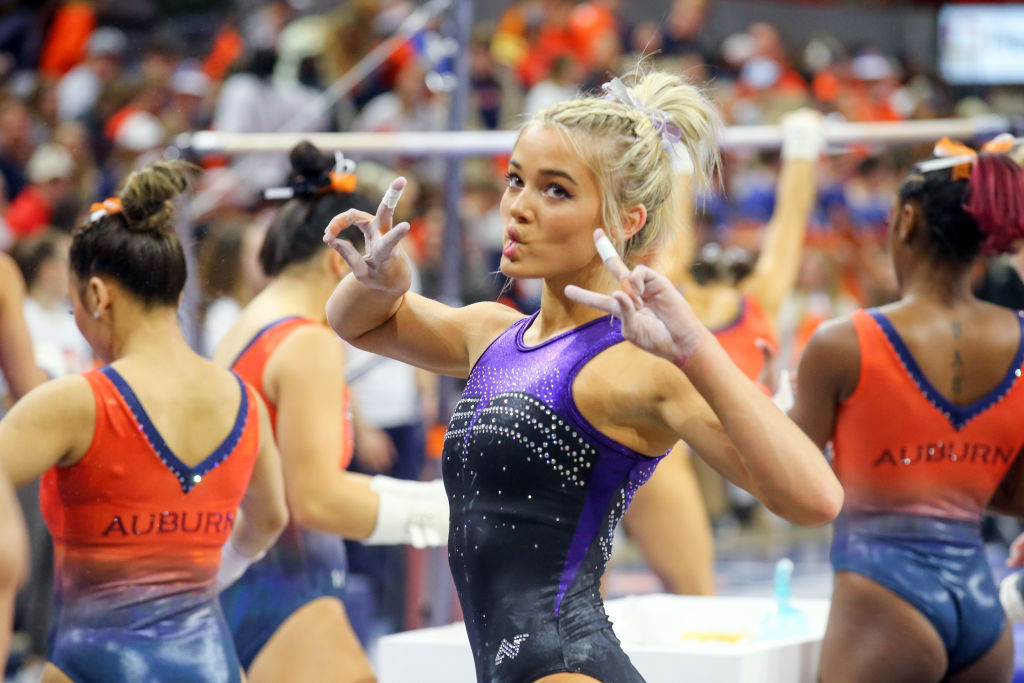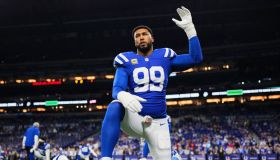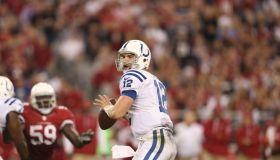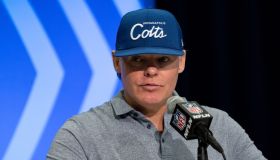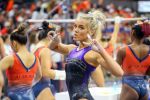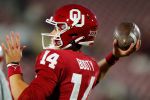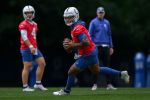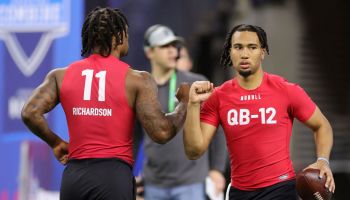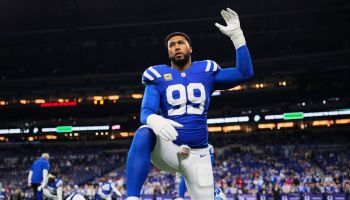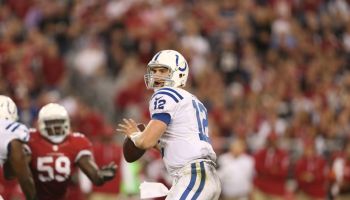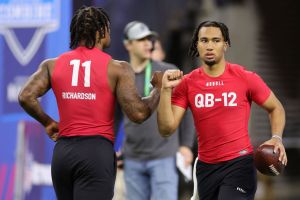
Source: Stacy Revere / Getty
INDIANAPOLIS – It’s (arguably) the most important personnel decision the Colts franchise has made in Jim Irsay’s time as owner.
This isn’t taking Peyton Manning at 1 overall or Andrew Luck back in 2012.
On April 27, the Colts will hold the No. 4 overall pick, on the verge of starting a different Week 1 quarterback for a 7th straight season, which ties the second longest streak in NFL history.
Irsay knows the Colts cannot continue down this path of constant QB rotation.
It’s time to take a big swing at the most important position in sports.
And with the Panthers sitting at No. 1, and the Texans at No. 2, it’s quite possible the Colts will be getting the 3rd or 4th choice at a quarterback in this draft.
We are going to focus on the 5 most popular names being pegged to go in Round 1 of the NFL Draft.
Let’s examine the quarterbacks (listed in alphabetical order):
Hendon Hooker (6-3, 217, Tennessee, transferred from Virginia Tech in 2021)
-Passing stats: 45 games, 66.9%, 8,974 yards, 80 TDs, 12 INTs; 172.2 rating
-Rushing (with sacks) stats: 517 attempts for 2,091 yards, 25 TDs
-Strengths: From a pure statistical standpoint, Hooker might be the most impressive QB in this class, especially when you factor in the dual-threat ability. Had Hooker not torn his ACL last November, he’s probably the Heisman Trophy winner. While some might use his age (25) as a con, Hooker has the most playing experience of these 5 on this list, and also faced some adversity by transferring. Plus, Hooker transferred to the premium conference in college football, and found tremendous success in moving from the ACC to the SEC. That has to be attractive to teams gauging how a player handles some unknown in college, and then takes his play to another level when the competition rises.
-Concerns: In some order, there are questions about the college system Hooker played in, his health and his age. Hooker, who turned 25 in January (and his older than several AFC quarterbacks), could be looking at a redshirt rookie season after tearing his ACL last November. But the collegiate system questions probably are more relevant to his long-term projection at this level. While Tennessee was incredibly explosive on offense with Hooker, they have a unique style in aligning their pass catchers near the college hashmarks, which are different in the NFL and not the same sort of spacing you have on a professional field (where the hashmarks are narrower). The reads Hooker made in college aren’t as relevant as those he’d have to make in the NFL, so some questions are there, too.
Will Levis (6-4, 229, Kentucky, transferred from Penn State in 2021)
-Passing stats: 38 games, 64.9%, 5,876 yards, 46 TDs, 25 INTs, 145.6 rating
-Rushing (with sacks) stats: 312 attempts for 742 yards, 17 TDs
-Strengths: From an arm, head and NFL system experience, Levis has himself in the top-5 chatter. It’s the 2021 film of Levis that really has some NFL people intrigued with Matthew Stafford-like comps. Levis played in two separate systems at Kentucky coordinated by former NFL offensive assistants, which makes him attractive in going from Saturday’s to Sunday’s. You can find plenty of NFL-type throws in an NFL-type offense on the Levis film. The arm strength of Levis is of zero question. The toughness of Levis is of no question. And many around the Kentucky program rave about his character, work ethic and the type of teammate he was with his fellow Wildcats (and we know that’s of umpteenth importance to the Colts). Similar to Hooker, transferring into the SEC is something NFL people are going to like, and respect.
-Concerns: There are certainly questions about Levis, with a less than ideal turnover number (25 career interceptions) and some issues with his processing and footwork. The senior year debate with Levis will be an interesting one for teams. With personnel around him changing and a new offensive coordinator, Levis’ play regressed in his second season starting for Kentucky. If you view a QB being able to lift a sinking ship, Levis had troubles in doing that last fall. How much of that was due to his own injuries? Or the environment around him? Processing and poise are such important traits for a quarterback and Levis’ big sack/turnover numbers are a reflection that he needs some real work there. How coachable is that? It might not be a big deal, but Levis does turn 24 years old this summer, which is on the older sign of rookie quarterbacks.
Anthony Richardson (6-4, 244, Florida)
-Passing stats: 22 games, 54.7%, 3,105 yards, 24 TDs, 15 INTs; 133.6 rating
-Rushing (with sacks) stats: 161 attempts for 1,116 yards, 12 TDs
-Strengths: The stuff you can’t teach. There haven’t been quarterback prospects possessing the physical makeup of Richardson. At 6-4 and 244 pounds, Richardson is built like a tight end or defensive end, yet can run like a running back, and also has arm strength an outfielder would dream of. Richardson is a ball of clay video gamers would use to ‘create a player.’ The physical attributes of his are salivating and beyond rare. But those around Florida also speak highly of how Richardson is wired and how he carries himself. Richardson’s best work last season also came more so against the top opponents on the Florida schedule. Also, Richardson is such a dynamic runner. That’s truly a game-changing element which should immediately translate to the NFL.
-Concerns: It starts with the accuracy. A completion percentage of 54.7 is a sore eye when you compare it to the others on this list. And that matters a lot when you hear Shane Steichen mention accuracy as the most important physical, on-field trait for a quarterback. Is teaching accuracy something the Colts should feel confident in? Richardson has just 13 starts in college, too. That’s an extremely small number. He’s obviously very raw, so it’ll be a tough balance for his NFL home to decide how much Richardson needs to sit and watch vs. actual playing reps, in trying to tap into his growth.
C.J. Stroud (6-3, 214, Ohio State)
-Passing stats: 26 games, 69.3%, 8,123 yards, 85 TDs, 12 INTs; 182.4 rating
-Rushing (with sacks) stats: 80 attempts for 136 yards, 1 TD
-Strengths: When Stroud called himself a ‘ball placement’ specialist at the Combine it was a really accurate description for the best thrower in this class. Stroud is a tremendous thrower of the football, and his gaudy numbers back that up. While Stroud did plenty in his collegiate career to be viewed as one of the first drafted QBs in 2023, his performance in the national semifinal against Georgia took things to another level. Stroud was outstanding in that game, showcasing an element with his legs that had been absent for much of his time at Ohio State. Against the national champions, on a massive stage, Stroud played like a star in helping Ohio State put up 41 points.
-Concerns: It probably sounds like a nitpick, but a question teams need to ask about Stroud is was the ease at which he made things look because of Ohio State’s massive difference in offensive talent on a weekly basis or because the quarterback was a huge factor in creating that disparity. Stroud didn’t have to face much adversity in college. So when things inevitably get tough in the NFL, how will he handle that? Is there enough of that Georgia ‘off-script’ stuff in Stroud’s game to translate to the NFL? Simply, Stroud’s questions are a lot different than the others on this list, and that’s why many have pegged him with the highest ‘floor’ of these 5 quarterbacks.
Bryce Young (5-10, 204, Alabama)
-Passing stats: 34 games, 65.8%, 8,356 yards, 80 TDs, 12 INTs; 165.0 rating
-Rushing (with sacks) stats: 139 attempts for 162 yards, 7 TDs
-Strengths: Poise and creator. No matter the chaos around Young, he hardly looks phased by the muddiness around him. When you watch him play quarterback, it’s clear you have a very intelligent signal caller. Also, Young played in the nation’s top conference and wasn’t working with typical Alabama type offensive talent around him, so more was put on his plate in terms of being that playmaker. Young strikes a great balance of executing the play at hand, while also offering some chances once things break down.
-Concerns: All of it is centered around the build of Young. He stands 5-10, but the 204-pound number at the Combine might be of more concern. Ideally, Young is playing at less than that number, too. And it’s very rare to see a sub 200-pound quarterback. So you are going to have definite durability/longevity questions for Young. It’s not that Young is some ‘run-first’ QB or a guy constantly looking to get out of the pocket and take off. But a guy holding up for a decade-plus at Young’s size has to be something discussed for all teams.
